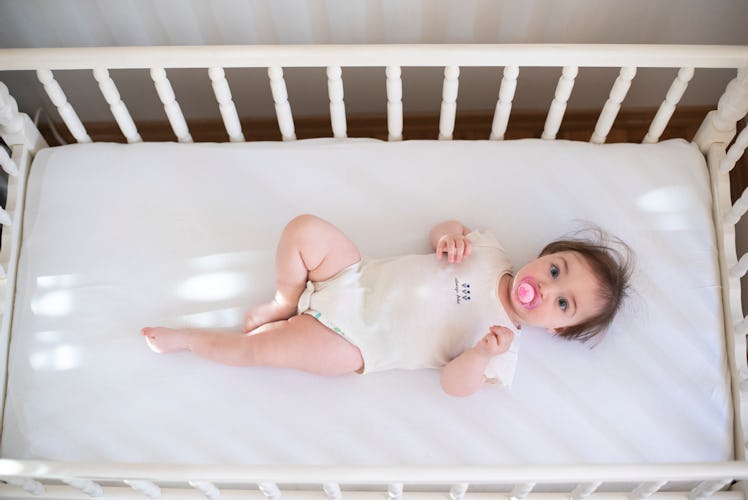Swaddling’s Out, Tummy Time’s In: New AAP Sleep Guidelines, Explained
New safe infant sleep guidelines are here — and parents should give them a read.

On Tuesday, June 21st, the American Academy of Pediatrics (AAP) updated its safe infant sleep guidelines. The new guidelines come just months after President Biden signed the Safe Sleep for Babies Act into law — a law that finally banned the sale of inclined sleepers and crib bumpers, products that have been associated with infant deaths.
The new rules will apply to infants up to 1-year-old and are being released at a time in which there remain racial disparities in the risk of infant death. In fact, per the AAP’s statements, the rate of sudden or unexplained infant death among Black and Native infants was two to three more common than in white infants from 2010-2013.
Some 3,500 infants die due to sleep-related reasons a year. The new rules come on the heels of more product recalls related to infant lounger and rocker products, just after Biden’s Safe Sleep For Babies Act, and just after the CPSC’s new rule on safe infant sleep products that just became enforceable.
The CPSC’s federal safety standard for sleep products means that all infant sleep products — cribs, bassinets, play yards, and bedside sleepers — must meet federal sleep safety standards (and have less than a 10% incline) and that parents should not use products for sleep that aren’t marketed for sleep. Products reaching the market that are marketed for sleep will have to meet CPSC standards as well.
13 Takeaways For Parents From The New Rules:
- Babies should sleep on flat, non-inclined surfaces that “at a minimum, adheres to the June 2021 Consumer Product Safety Commission’s” rule on safe infant sleep products. Using a “firm, flat, non inclined sleep surface” will reduce the risk of suffocation, wedging, or entrapment. If it is not flat, it has to adhere to the CPSC rule.
- Sitting devices — like car seats, swings, slings, and more, are not recommended for routine sleep, in particular for infants younger than 4 months. If a baby falls asleep in them, they should be moved to a flat surface — ideally, their crib, which is empty of any objects, and always sleep on their backs.
- Keep cribs empty. “Keep soft objects such as pillows, pillow-like toys, quilts, comforters,” and more away from the infant’s sleep area.
- Breastfeeding is recommended because it reduces the risk of sleep-related infant deaths. In particular, the AAP recommends exclusive human milk feeding for 6 months with the continuation of human milk feeding for a year. The AAP acknowledges that breastfeeding is not possible for all families.
- Parents should sleep in the same room as their infant for the first six months of their life, but not in the same bed for at least the first six months. In other words, cosleeping is now never recommended for young infants.
- Avoid infant and parent exposure to nicotine, alcohol, opioids, marijuana, and other drugs.
- Make sure your baby is routinely vaccinated.
- Pacifier use at naptime and bedtime is recommended and “is associated with reducing risk” of infant-related sleep deaths.
- Avoid hats — “head-coverings” and overheating in infants.
- Pregnant people should get regular prenatal care.
- Avoid commercially available devices that claim to reduce SIDS risk. The AAP says “there is no evidence that any of these devices reduce the risk of deaths” and that the products might make parents feel a “false sense of security and complacency. Do not use home cardiorespiratory monitors as a strategy to reduce the risk of SIDS.”
- Supervised, awake tummy time is recommended soon after taking the baby home from the hospital and should increase “incrementally” to make sure that there are 15-30 minutes of total tummy time every day by the 7-week mark.
- Swaddling has no evidence of efficacy. “There is no evidence to recommend swaddling as a strategy to reduce the risk of SIDS,” the new rules say. “Weighted swaddles, weighted clothing, or weighted objects on or near the baby are not safe,” and when a baby begins to try to roll, “swaddling is no longer appropriate.”
There are more rules, but these are focused on doctors and the media. For example, the AAP says it is “essential” that physicians and other providers endorse and model safe infant sleep guidelines and that media and manufacturers follow guidelines in their messaging and advertising.
While the AAP strongly does not endorse bedsharing, they acknowledge that parents will continue to do so for many reasons. Because of that, the AAP did note three of the most dangerous practices of cosleeping: co-sleeping when a parent is on medications that make them less alert, cosleeping when a parent is a smoker, or co-sleeping on a soft surface like a couch or water bed. The organization still maintains that no one should cosleep, but that infants should sleep in the same room as their parents for the first six months of their life.
Other new guidelines of course include the inclusion of the CPSC rule for safe infant sleep products, the new notice on sleeping with hats or head coverings, and the recommendation against using sleep-tech that claims to reduce the risk of SIDs.
If all of that is a bit much, the ABCs of infant sleep are still very true. Infants should sleep alone in their cribs, with no soft toys, blankets, pillows, or crib bumpers, on their backs lying flat, and in their crib, not on a couch, in their parent's bed, or in a rocker. For more info, check out healthychildren.org.
This article was originally published on